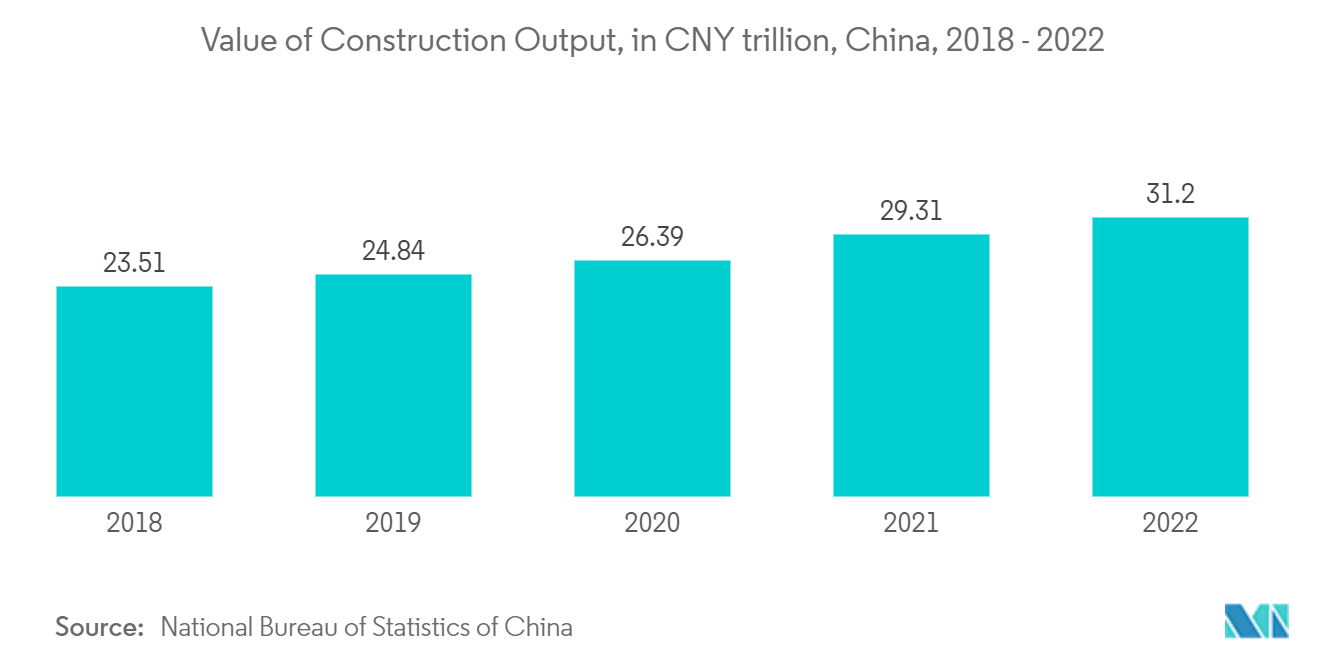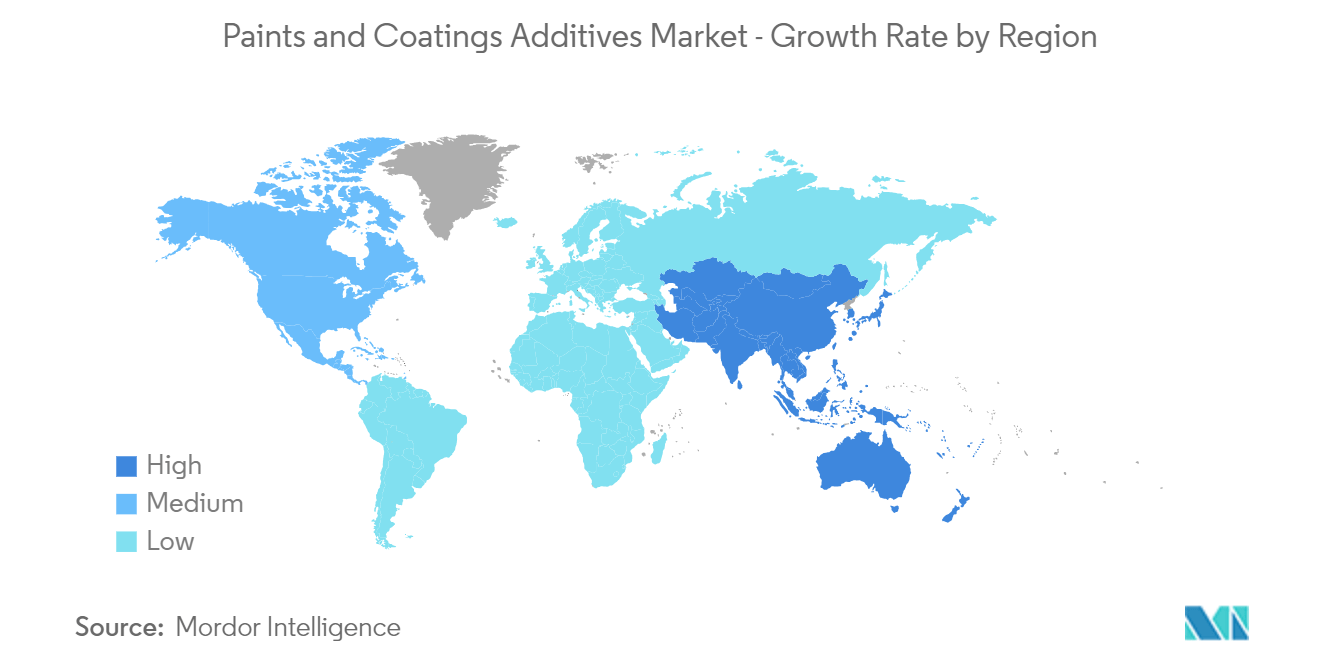Market Trends of Paints and Coatings Additives Industry
Architectural Segment to Dominate the Market
- The architectural segment includes additives used in coatings for commercial purposes, such as office buildings, warehouses, retail convenience stores, shopping malls, and residential buildings.
- Some majorly used additives for architectural coatings include rheological modifiers, defoamers, dispersants, and wetting agents.
- Generally, the additives used for architectural coatings help to enhance surface properties, stabilizing pigment, enhancing wetting, dispersing, and defoaming properties, etc.
- According to the US Census Bureau, the value of new construction output in the United States amounted to USD 1,792.9 billion in December 2022. The non-residential sector accounted for USD 997.14 billion in March 2023, registering a growth of 18.8% compared to the same period of the previous year.
- Moreover, according to the US Census Bureau, the private and public construction non-residential spending in June 2022 was 492.68 billion, which showed an increase of 1.74% compared to June 2021, which amounted to USD 484.26 billion. Therefore, increasing spending on private and public non-residential constructions in the country is expected to create an upside demand for the paints and coatings additives market.
- Apart from that, there are various construction commercial projects scheduled in the United States Red Bull North America's USD 740 million worth 2 million sq ft processing and distribution facility in Concord, North Carolina, Dairy cooperative DairgoldUSD 500 million worth 400,000 sq ft processing facility in Port of Pasco, Washington (completion scheduled for 2023), Biotics Research Corporation USD 9 million worth 88,000 sq ft warehouse, laboratory, and office facility in Rosenberg, Texas (completion scheduled for 2023).
- Increasing investment in residential constructions in Saudi Arabia is expected to boost the demand for the paints and coatings additives market. For instance, in Saudi Arabia, the growing number of real estate developments, increasing demand for residential property, and governmental initiatives to develop socio-economic infrastructure drive the country's paints and coatings additives market. According to Majid Al-Hogail, the Saudi Housing Minister, the Kingdom of Saudi Arabia plans to construct 300,000 extra housing units over the next five years. One of Saudi Arabia's significant initiatives under Vision 2030 is housing. It will likely create demand for the paints and coatings additives market from the country's construction sector in the upcoming years.
- Such initiatives by the government are expected to rapidly boost the construction industry. It is also further boosting the consumption of coating and, in turn, coating additives in the construction sector.
- Hence, all such residential construction investments and projects are driving construction activities in these countries, along with the consumption of paints and coatings for application in residential construction.

Asia-Pacific to Dominate the Market
- Asia-Pacific is aiming for the development of its paints and coatings sector. It is on the way to becoming the center of the global paints and coatings supply chain, leveraging its easy access to key feedstock, production of basic molecules, and access to the regional market.
- Asia-Pacific includes a persistent expedition in making some of the tallest, largest, and biggest structures. The paints and coatings industry in the country is expected to register steady growth in the coming years. The construction industry is poised to witness sturdy growth in the forthcoming years, augmenting the demand for coating additives.
- China holds the largest Asia-Pacific market share for the paints and coatings additives market. The demand for the paints and coatings additives market is expected to rise throughout the forecast period due to rising investments and construction activity in the country. China is a huge contributor, as it is one of the leading investors in infrastructure worldwide over the past few years. For instance, according to the National Bureau of Statistics (NBS) of China, in 2022, the output value of construction works in China amounted to CNY 31.2 trillion (USD 475.84 billion), an increase of 6.5% compared with 2021.
- Moreover, in China, according to the country's Ministry of Housing and Urban-Rural Development, the construction industry will maintain a 6% share of the country's GDP by 2025. There is a growing trend in the country for prefabricated buildings, which is expected to account for more than 30% of the country's new construction.
- According to the National Development and Reform Commission, the Chinese government approved 26 infrastructure projects at an estimated investment of about USD 142 billion, estimated to be completed by 2023. The growing demand for housing is expected to drive residential construction in the public and private sectors. Therefore, increasing investments in residential construction is expected to create an upside demand for the paints and coatings additives market from the country's construction industry.
- India is anticipated to remain the fastest-growing G20 economy in the Asia-Pacific region. The Indian government announced a target of USD 376.5 billion in infrastructure investment over three years (2023-2025). It includes USD 120.5 billion for developing 27 industrial clusters and USD 75.3 billion for road, railway, and port connectivity projects. Therefore, this will likely create an upside for paints and coatings additives from the country's construction industry.
- Moreover, according to IBEF, in Union Budget 2022-2023, the government allocated INR 10 trillion (USD 130.57 billion) to enhance the infrastructure sector. Moreover, India plans to spend USD 1.4 trillion on infrastructure through the 'National Infrastructure Pipeline' in the next five years.
- Furthermore, the civil aviation minister announced that the Indian government is also planning to construct 100 airports by 2032, owing to increasing demand for air commutes.
- The factors above are expected to make the Asia-Pacific the dominant globally during the forecast period.


